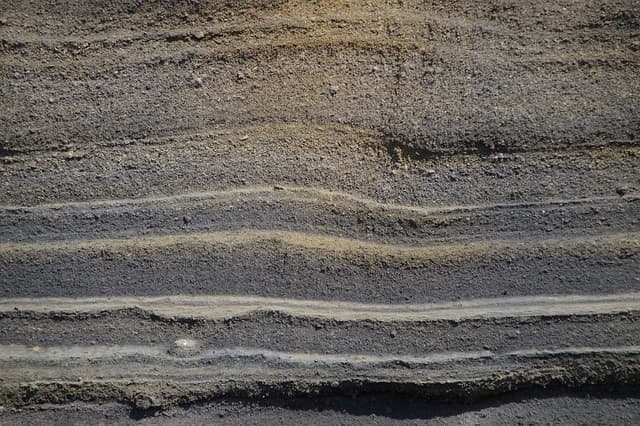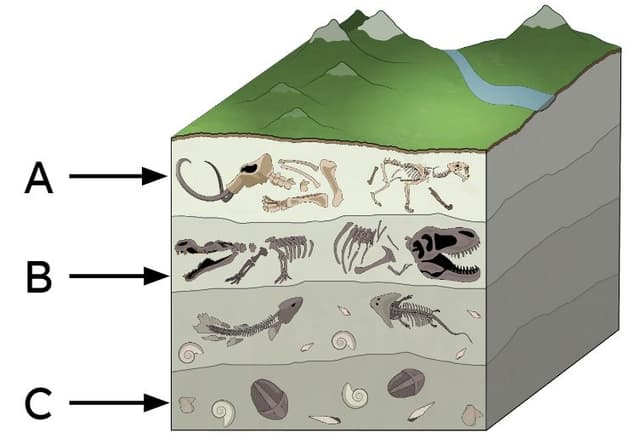Starter quiz
- Which of these pictures show layers?
 A ✓
A ✓ B
B C
C D ✓
D ✓
- Which of these are fossils?
 A
A B ✓
B ✓ C ✓
C ✓ D
D
- Fossils can tell us about things that lived ...
- 10 years ago.
- 100 years ago.
- 1000 years ago.
- over 10,000 years ago. ✓
-
- Which of these statements about fossils are correct?
- All fossils are the remains of dinosaurs.
- The soft parts of living things don’t usually become fossilised. ✓
- All the fossils on Earth have already been discovered.
- Fossils give us clues about life on Earth long ago. ✓
-
- Rocks that are formed by layers of sediment building up over time are called ______ rocks.
- 'sedimentary' ✓
- Starting with the first, order the steps in fossil formation.
- 1⇔An organism dies and sinks to the bottom of the ocean.
- 2⇔The soft parts of the organism decay.
- 3⇔The hard parts of the organism are covered with multiple layers of sediment.
- 4⇔After many years, the hard parts of the animal are replaced by minerals.
Exit quiz
- The layers at the bottom of ______ rock are the oldest and the layers at the top are the newest.
- 'sedimentary' ✓
- Why do scientists use models?
- They are fun to create.
- They are more interesting than just reading words.
- They help us to understand things that we can’t see for ourselves. ✓
-
 A scientist who studies rocks to learn about what was happening on Earth at different times is called a...
A scientist who studies rocks to learn about what was happening on Earth at different times is called a...- 'geologist' ✓
- Which of these statements about fossils is correct?
- Fossils of the simplest organisms are found in the oldest rocks. ✓
- Fossils of the most complex organisms are found in the newest rocks.
- Fossils of the simplest organisms are found in the newest rocks.
-
 In which layer of rock would geologists be likely to find fossils of animals with very complex structures such as sabre-toothed tigers?
In which layer of rock would geologists be likely to find fossils of animals with very complex structures such as sabre-toothed tigers?- A ✓
- B
- C
-
- Why is it useful for geologists to know which layer of rock a fossil was found in?
- Because it tells us how the organism moved.
- Because it tells us what the animal’s diet was like.
- Because it tells us which plants and animals lived in each time period. ✓
- Because it tells us how large the organism was.
-
Worksheet
Presentation
Video
Lesson Details
Key learning points
- The layers at the bottom of sedimentary rock are the oldest and the layers at the top are the newest
- By looking at different layers of rock, geologists can learn about what was happening on Earth at different times
- Where a fossil is found can tell us about which animals or plants lived in each time period in the history of our Earth
- Fossils of the simplest organisms are found in the oldest rocks, and more complex organisms in the newest rocks
- Models can be used to represent different layers of fossils in rock over time
Common misconception
Pupils may think that all prehistoric living things were on Earth at the same time, rather than understanding that life on Earth changed over millions of years.
Use the models and information in the lesson to explain that the different layers of rock beneath our feet were formed at different times, and there are fossils of different living things buried within each.
Keywords
Sedimentary rock - Sedimentary rock is formed when sediment collects at the bottom of a lake or sea.
Geologist - A geologist is a scientist who studies what Earth is made of.
Evidence - Evidence is information which helps us to prove that something is true or not true.
Fossil - A fossil is the remains or imprint of living things that are sometimes preserved in rock.
Model - A model is used to describe something that can't be experienced directly.